Spotted Wing Drosophila (SWD)
Squash Vine Borer
Three-lined Potato Beetle
Powdery Mildew
Squash Bug
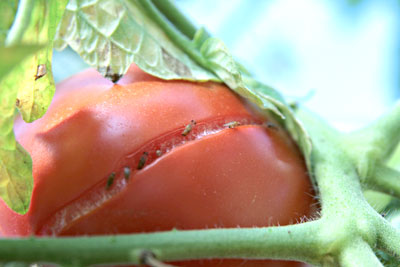 |
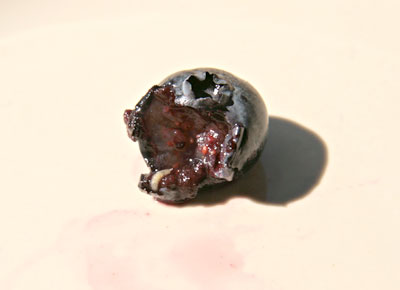 |
| SWD on a tomato | Drosophila maggot in a berry |
SPOTTED WING DROSOPHILA
Spotted wing drosophila captures and presence in small fruit is earlier and bigger than I have ever seen. Even our late strawberries hosted maggots, and I have never seen a strawberry with SWD maggots before. The only typical host crop that seems clean for us now is blueberry, and that is only because the raspberries are in the row next to them and are acting like a trap crop. They love raspberries.
The spotted wing Drosophila, as most of you know by now, is a species of fruit fly that, unlike the typical fruit fly found around overripe fruit, can pierce the skin of just ripe fruit and lay an egg. Most of you also know by now that the egg hatches and the larvae consume the fruit from the inside out. Watch out for soft fruit.
The fly is easy to recognize. It looks like a regular fruit fly, but there are spots on the wings.
Management is all about harvesting and post harvest handling. Pick the fruit often and do not allow ripe fruit to hang around. After picking, refrigerate or freeze quickly. Do not leave baskets of fruit at room temperature, unless you want to raise maggots.
Spinosad (Entrust or Monterey Garden Spray) is actually very effective, however not practical nor, in most situations, legal. The problem is that the fruit fly has a very quick and large ability to reproduce. The populations become very large by late summer. Spraying would have to happen every 3-5 days to be really effective, and there is a label limit of only 3 sprays per crop. So, management for organic growers is all about harvesting and post harvest handling.
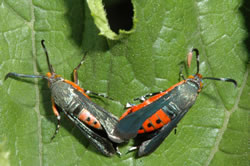 |
| Hawk moths, adult form of the squash vine borer |
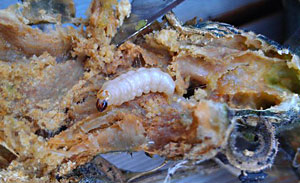 |
| Squash vine borer, larval phase, inside a zucchini stem. Photo by Massiv99. Licensed under CC0 via Wikimedia Commons |
SQUASH VINE BORER
Squash vine borer moths are day-flying moths with a 1.0 to 1.5 inch wingspan and bright orange markings. In flight, they look like wasps. There is one generation each year and adults emerge in late June/early July. The moths fly slowly in zig-zags around plants and lay eggs singly on stems; eggs are usually found on the main stem near the base, but are also found on leafstalks or on the undersides of leaves. Upon hatching, larvae bore into stems (where they are protected from insecticides). Thick-stemmed squashes are preferred. Unless you use traps or scout fields for evidence of eggs or larvae, the first sign of squash vine borer infestation is often wilting vines in July and August. By that time, it is too late to do anything.
Growers should scout their pumpkin and squash fields weekly for squash vine borer from late June through early August. Examine the base of vines for eggs. The squash vine borer can be killed with an insecticide and the recommendation would be spinosad (for example, Entrust or Monterey Garden Spray), but appropriate timing is crucial. Bt also works, but Bt breaks down more quickly. Bt aizawai (for example Agree WG) has been shown to work better than Bt kurstaki (for example Dipel). Either insecticide is only effective when applied for young larvae to eat before they bore into the stem. Once they are in the stem the insecticide will be useless. If you see the moths flying or find eggs, then two insecticide sprays, ideally applied to the base of the plants and timed five to seven days apart, will control newly hatching larvae before they are able to bore into the stem. Again, the timing is crucial and there is no point in spraying before you find evidence, or after the larvae bore into the stem.
If evidence of larval feeding (sawdust-like frass near entrance holes) is found, then split open the stem to confirm the presence of larvae, which, by the way, may suggest more eggs are being laid so scout. Borers can be removed from vines if detected before much damage is done. Slit the stem longitudinally, remove the borer, then cover the wounded stem with moist soil above the point of injury to promote additional root formation.
Some growers monitor for the moths using Scentry Heliothis pheromone traps from early June through early August. If more than 5 moths per week are captured, then they make 2 to 4 weekly applications of pesticides. Timing is very important, so this is not recommended for the casual gardener. (Source material from New England Vegetable Management Guide; Handbook of Vegetable Pests, A Capinera; ATTRA, UMass Vegetable Newsletter and URI Extension Fact Sheet)
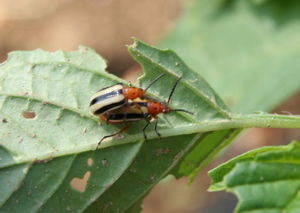 |
| Three-lined potato beetles. Photo by Eric Sideman. |
CUCUMBER BEETLES ON MY POTATOES and TOMATILLO?
No. Those are not cucumber beetles. Potatoes, tomatoes and sometimes eggplants are attacked by this pest that only superficially looks like a cucumber beetle. This is the THREE-LINED POTATO BEETLE. The adult of this pest is about the same size as a cucumber beetle, but has a reddish head and a thorax with two dark spots. The wing covers are dark yellow with three black stripes. Its favorite food in my experience is tomatillo.
The Three-Lined Potato Beetle overwinters as an adult and wakes early in the spring. They are there waiting for you to plant your solanaceous crops. The females soon begin laying eggs that hatch in about two weeks to larvae that look a bit like Colorado potato beetle larvae, except these critters have the endearing practice of carrying a small pile of their own excrement on their back. The larvae mature in about two weeks. There are probably two generations per year.
On most crops the level of the pest does not warrant control. If this pest has been a problem in the past, floating row covers will help you avoid the overwintering adults and that should get you by. Hand picking will work on small plantings. Pyganic and Entrust may offer some relief, but in my experience, little. Rotenone works well, BUT REMEMBER THAT THERE ARE NO ROTENONE IS NOT A REGISTERED PESTICIDE ANY MORE, AND SHOULD NOT BE USED.
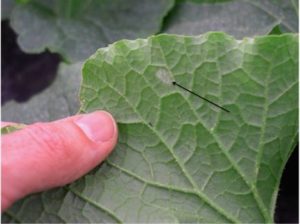 |
| Powdery mildew |
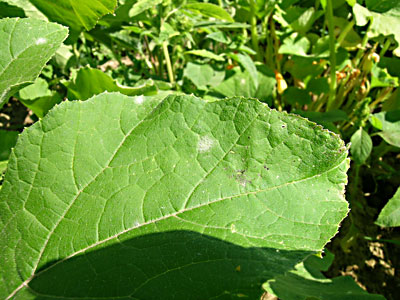 |
| Powdery mildew on the top surface of a pumpkin leaf |
POWDERY MILDEW
Powdery mildew is a common disease of pumpkins and winter squash. All cucurbits are susceptible, but many common cucumber and melon varieties are resistant. The disease can cause infected leaves to die prematurely, reducing yields and lowering fruit quality, especially taste. Winter squash from diseased plants won’t store as long as fruits from healthy plants. The fungus that causes the disease does not overwinter in Maine. Spores blow up every year from southern overwintering sites. If they arrive late in the season, you may not need any control; but if they arrive in early to midsummer, exercise some control or you may have no leaves by mid-August, or bland starchy squash.
I have not seen any yet. Go out and scout. Check upper and lower surfaces of leaves of older plants every few days starting now. The first symptoms usually are white, powdery fungal patches on the undersides of older leaves. Yellow spots may form opposite these, on the upper leaf surfaces.
No products with systemic activity (products that move through the plant) are approved for organic production, and applying fungicide to the lower leaf surface is difficult. In experiments, foliar applications of sulfur have been more effective than most other organic products for powdery mildew, apparently because sulfur deposited on the upper leaf surface can volatilize and be redistributed to the lower surface. Sulfur can be phytotoxic on melons, especially if applied when temperatures are hot.
There are some new products made from potassium bicarbonate (Kaligreen and Milstop are two of these) that are showing good efficacy. For a good discussion of these, including efficacy, see the new edition of the Resource Guide to Organic Insect and Disease Management at: https://web.pppmb.cals.cornell.edu/resourceguide/
ATTRA (National Sustainable Agriculture Information Service, https://www.attra.ncat.org) reports that a single spray application (to runoff) of 0.5 percent (wt./vol. of water) baking soda, plus 0.5 percent (vol./vol. of water) SunSpray UFP® horticultural oil almost completely inhibited powdery mildew on heavily infected pumpkin foliage; while baking soda without the oil was ineffective, and a 2 percent (wt./vol. of water) solution of baking soda damaged the leaves.
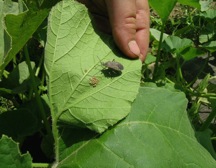 |
| Squash bug adult and eggs |
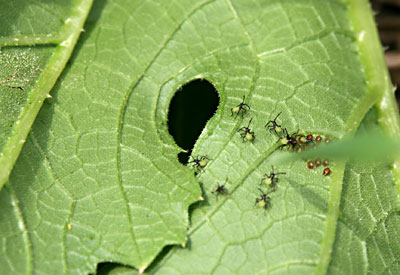 |
| Squash bug hatch |
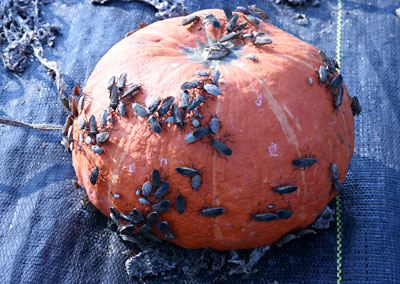 |
| Squash bug adults and older nymphs |
SQUASH BUG
Squash bugs are serious pests of pumpkins and squash throughout North America. Damage and survival are low on watermelon, very low on cucumber and muskmelon, and highest on squash and pumpkin. Both adults and nymphs feed by inserting their beak and sucking juices from plant tissue. Toxic saliva injected during feeding causes foliage to wilt, then leaves turn black and die; the severity of this damage is directly related to density of squash bugs on each plant. Often I get calls by growers who believe they have a disease. Later in the season, squash bugs may feed on the fruit, causing them to collapse or become unmarketable.
Adults are 0.5 to 0.75 of an inch long, flattened and grayish-brown. They hibernate in trash in and around the garden for the winter and emerge in the early summer to feed a bit and lay eggs. Eggs are laid in clusters usually on the underside of leaves and are orange when first laid, but turn bronze-colored before they hatch. The wingless nymphs are similar in appearance to adults, and are whitish when small, with a brown head, and grayish white when larger with black legs. There is one generation per year in the Northeast.
Black plastic, straw mulch, and reduced tillage systems encourage higher populations, probably by providing good hiding places. Squash bug numbers are reduced by clean cultivation in the fall, and crop rotation. Infestation is delayed by row covers. If possible, rotate cucurbit crops between fields as far apart as possible. Keep headlands mowed and free of trash to reduce overwintering sites.
Squash bugs are unusually difficult to control with insecticides. Scout undersides of leaves for squash bug adults and eggs. Crush the eggs. You may not want to crush the bugs as they stink when you do.
If you miss some eggs and have to spray, time squash bug sprays to kill young nymphs just after hatch, because this stage is the easiest to control. Treat late in the day when the flowers are closed to reduce risk to bees. Neem products have proved effective.
For adult bug control, insecticides applied to the base of the plant are most effective, possibly because bugs tend to cluster. But, squash bugs are virtually impossible to control later in the season when nymphs are large and the canopy is dense.
(Source material from New England Vegetable Management Guide; Handbook of Vegetable Pests, A Capinera; ATTRA. And UMass Extension article by Andy Cavanagh & R Hazzard)
